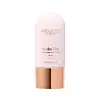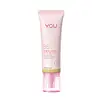Sculpted by Aimee Hydratint Moisturising Tinted Serum SPF 20 Versus Y.O.U Simplicity Perfect BB Cream
What's inside
What's inside
 Key Ingredients
Key Ingredients

 Benefits
Benefits

 Concerns
Concerns

 Ingredients Side-by-side
Ingredients Side-by-side

Water
Skin ConditioningCentella Asiatica Extract
CleansingDimethicone
EmollientGlycerin
HumectantPhenyl Trimethicone
Skin ConditioningDipropylene Glycol
HumectantCaprylic/Capric Triglyceride
MaskingCetyl PEG/PPG-10/1 Dimethicone
EmulsifyingVinyl Dimethicone/Methicone Silsesquioxane Crosspolymer
Sodium Chloride
MaskingCeramide NP
Skin ConditioningSodium Hyaluronate
HumectantEthylhexylglycerin
Skin ConditioningMethicone
EmollientCarnosine
Skin ConditioningTocopherol
AntioxidantButylene Glycol
Humectant1,2-Hexanediol
Skin ConditioningLauryl PEG-9 Polydimethylsiloxyethyl Dimethicone
Skin ConditioningSorbitan Isostearate
EmulsifyingSorbitan Olivate
EmulsifyingStearalkonium Hectorite
Gel FormingTrimethylsiloxysilicate
EmollientTriethoxycaprylylsilane
Propylene Carbonate
SolventAluminum Hydroxide
EmollientSilica
AbrasivePhenoxyethanol
PreservativeCI 77891
Cosmetic ColorantIron Oxides
CI 77492
Cosmetic ColorantCI 77491
Cosmetic ColorantCI 77499
Cosmetic ColorantWater, Centella Asiatica Extract, Dimethicone, Glycerin, Phenyl Trimethicone, Dipropylene Glycol, Caprylic/Capric Triglyceride, Cetyl PEG/PPG-10/1 Dimethicone, Vinyl Dimethicone/Methicone Silsesquioxane Crosspolymer, Sodium Chloride, Ceramide NP, Sodium Hyaluronate, Ethylhexylglycerin, Methicone, Carnosine, Tocopherol, Butylene Glycol, 1,2-Hexanediol, Lauryl PEG-9 Polydimethylsiloxyethyl Dimethicone, Sorbitan Isostearate, Sorbitan Olivate, Stearalkonium Hectorite, Trimethylsiloxysilicate, Triethoxycaprylylsilane, Propylene Carbonate, Aluminum Hydroxide, Silica, Phenoxyethanol, CI 77891, Iron Oxides, CI 77492, CI 77491, CI 77499
Water
Skin ConditioningCyclopentasiloxane
EmollientGlycerin
HumectantDimethicone
EmollientPropylene Glycol
HumectantCaprylic/Capric Triglyceride
MaskingTridecyl Trimellitate
EmollientIsohexadecane
EmollientIsononyl Isononanoate
EmollientLauryl PEG-10 Tris(Trimethylsiloxy)Silylethyl Dimethicone
EmulsifyingCaprylyl Methicone
Skin ConditioningTrimethylsiloxysilicate
EmollientSodium Chloride
MaskingDisteardimonium Hectorite
StabilisingSilica
AbrasiveCetyl PEG/PPG-10/1 Dimethicone
Emulsifying1,2-Hexanediol
Skin ConditioningPolymethyl Methacrylate
PEG-10 Dimethicone
Skin ConditioningPhenoxyethanol
PreservativeSorbitan Isostearate
EmulsifyingTriethoxycaprylylsilane
Dimethicone/Vinyl Dimethicone Crosspolymer
Skin ConditioningAluminum Hydroxide
EmollientPEG-9 Polydimethylsiloxyethyl Dimethicone
EmulsifyingParfum
MaskingButylene Glycol
HumectantEthylhexylglycerin
Skin ConditioningMica
Cosmetic ColorantTrehalose
HumectantHamamelis Virginiana Extract
AntiseborrhoeicDendrobium Nobile Extract
Skin ConditioningPentylene Glycol
Skin ConditioningPortulaca Oleracea Extract
Skin ConditioningAloe Barbadensis Leaf Extract
EmollientSophora Flavescens Root Extract
AntioxidantLycium Barbarum Fruit Extract
AstringentEchinacea Purpurea Extract
MoisturisingBiosaccharide Gum-4
Skin ConditioningPrunus Persica Flower Extract
MoisturisingSodium Acetylated Hyaluronate
HumectantTocopherol
AntioxidantSodium Hyaluronate
HumectantXanthan Gum
EmulsifyingSodium Hyaluronate Crosspolymer
HumectantHydrolyzed Sodium Hyaluronate
Skin ConditioningWater, Cyclopentasiloxane, Glycerin, Dimethicone, Propylene Glycol, Caprylic/Capric Triglyceride, Tridecyl Trimellitate, Isohexadecane, Isononyl Isononanoate, Lauryl PEG-10 Tris(Trimethylsiloxy)Silylethyl Dimethicone, Caprylyl Methicone, Trimethylsiloxysilicate, Sodium Chloride, Disteardimonium Hectorite, Silica, Cetyl PEG/PPG-10/1 Dimethicone, 1,2-Hexanediol, Polymethyl Methacrylate, PEG-10 Dimethicone, Phenoxyethanol, Sorbitan Isostearate, Triethoxycaprylylsilane, Dimethicone/Vinyl Dimethicone Crosspolymer, Aluminum Hydroxide, PEG-9 Polydimethylsiloxyethyl Dimethicone, Parfum, Butylene Glycol, Ethylhexylglycerin, Mica, Trehalose, Hamamelis Virginiana Extract, Dendrobium Nobile Extract, Pentylene Glycol, Portulaca Oleracea Extract, Aloe Barbadensis Leaf Extract, Sophora Flavescens Root Extract, Lycium Barbarum Fruit Extract, Echinacea Purpurea Extract, Biosaccharide Gum-4, Prunus Persica Flower Extract, Sodium Acetylated Hyaluronate, Tocopherol, Sodium Hyaluronate, Xanthan Gum, Sodium Hyaluronate Crosspolymer, Hydrolyzed Sodium Hyaluronate
Ingredients Explained
These ingredients are found in both products.
Ingredients higher up in an ingredient list are typically present in a larger amount.
1,2-Hexanediol is a synthetic liquid and another multi-functional powerhouse.
It is a:
- Humectant, drawing moisture into the skin
- Emollient, helping to soften skin
- Solvent, dispersing and stabilizing formulas
- Preservative booster, enhancing the antimicrobial activity of other preservatives
Aluminum Hydroxide is a form of aluminum. It can be naturally found in nature as the mineral gibbsite. In cosmetics, Aluminum Hydroxide is used as a colorant, pH adjuster, and absorbent.
As a colorant, Aluminum Hydroxide may add opacity, or reduce the transparency. Aluminum hydroxide is contains both basic and acidic properties.
According to manufacturers, this ingredient is an emollient and humectant. This means it helps hydrate the skin.
In medicine, this ingredient is used to help relieve heartburn and help heal ulcers.
There is currently no credible scientific evidence linking aluminum hydroxide in cosmetics to increased cancer risk.
Major health organizations allow the use of aluminum hydroxide in personal care products and have not flagged it as a carcinogenic risk at typical usage levels.
Learn more about Aluminum HydroxideButylene Glycol (or BG) is used within cosmetic products for a few different reasons:
Overall, Butylene Glycol is a safe and well-rounded ingredient that works well with other ingredients.
Though this ingredient works well with most skin types, some people with sensitive skin may experience a reaction such as allergic rashes, closed comedones, or itchiness.
Learn more about Butylene GlycolThis ingredient is an emollient, solvent, and texture enhancer. It is considered a skin-softener by helping the skin prevent moisture loss.
It helps thicken a product's formula and makes it easier to spread by dissolving clumping compounds.
Caprylic Triglyceride is made by combining glycerin with coconut oil, forming a clear liquid.
While there is an assumption Caprylic Triglyceride can clog pores due to it being derived from coconut oil, there is no research supporting this.
Learn more about Caprylic/Capric TriglycerideThis ingredient is a high molecular weight silicone. It has emulsifying and skin conditioning properties.
Dimethicone is a type of synthetic silicone created from natural materials such as quartz.
What it does:
Dimethicone comes in different viscosities:
Depending on the viscosity, dimethicone has different properties.
Ingredients lists don't always show which type is used, so we recommend reaching out to the brand if you have questions about the viscosity.
This ingredient is unlikely to cause irritation because it does not get absorbed into skin. However, people with silicone allergies should be careful about using this ingredient.
Note: Dimethicone may contribute to pilling. This is because it is not oil or water soluble, so pilling may occur when layered with products. When mixed with heavy oils in a formula, the outcome is also quite greasy.
Learn more about DimethiconeEthylhexylglycerin (we can't pronounce this either) is commonly used as a preservative and skin softener. It is derived from glyceryl.
You might see Ethylhexylglycerin often paired with other preservatives such as phenoxyethanol. Ethylhexylglycerin has been found to increase the effectiveness of these other preservatives.
Glycerin is already naturally found in your skin. It helps moisturize and protect your skin.
A study from 2016 found glycerin to be more effective as a humectant than AHAs and hyaluronic acid.
As a humectant, it helps the skin stay hydrated by pulling moisture to your skin. The low molecular weight of glycerin allows it to pull moisture into the deeper layers of your skin.
Hydrated skin improves your skin barrier; Your skin barrier helps protect against irritants and bacteria.
Glycerin has also been found to have antimicrobial and antiviral properties. Due to these properties, glycerin is often used in wound and burn treatments.
In cosmetics, glycerin is usually derived from plants such as soybean or palm. However, it can also be sourced from animals, such as tallow or animal fat.
This ingredient is organic, colorless, odorless, and non-toxic.
Glycerin is the name for this ingredient in American English. British English uses Glycerol/Glycerine.
Learn more about GlycerinPhenoxyethanol is a preservative that has germicide, antimicrobial, and aromatic properties. Studies show that phenoxyethanol can prevent microbial growth. By itself, it has a scent that is similar to that of a rose.
It's often used in formulations along with Caprylyl Glycol to preserve the shelf life of products.
Silica, also known as silicon dioxide, is a naturally occurring mineral. It is used as a fine, spherical, and porous powder in cosmetics.
Though it has exfoliant properties, the function of silica varies depending on the product.
The unique structure of silica enhances the spreadability and adds smoothness, making it a great texture enhancer.
It is also used as an active carrier, emulsifier, and mattifier due to its ability to absorb excess oil.
In some products, tiny microneedles called spicules are made from silica or hydrolyzed sponge. When you rub them in, they lightly polish away dead skin layers and enhance the penetration of active ingredients.
Learn more about SilicaChances are, you eat sodium chloride every day. Sodium Chloride is also known as table salt.
This ingredient has many purposes in skincare: thickener, emulsifier, and exfoliator.
You'll most likely find this ingredient in cleansers where it is used to create a gel-like texture. As an emulsifier, it also prevents ingredients from separating.
There is much debate on whether this ingredient is comedogenic. The short answer - comedogenic ratings don't tell the whole story. Learn more about comegodenic ratings here.
The concensus about this ingredient causing acne seems to be divided. Research is needed to understand if this ingredient does cause acne.
Scrubs may use salt as the primary exfoliating ingredient.
Learn more about Sodium ChlorideSodium Hyaluronate is hyaluronic acid's salt form. It is commonly derived from the sodium salt of hyaluronic acid.
Like hyaluronic acid, it is great at holding water and acts as a humectant. This makes it a great skin hydrating ingredient.
Sodium Hyaluronate is naturally occurring in our bodies and is mostly found in eye fluid and joints.
These are some other common types of Hyaluronic Acid:
Learn more about Sodium HyaluronateSorbitan Isostearate is an emulsifer and cleaning agent. It is created from isostearic acid and sorbitol.
As an emulsifier, Sorbitan Isostearate prevents oils and water from separating.
Due to its isostearic acid base, it may not be safe for Malassezia or fungal acne.
Learn more about Sorbitan IsostearateTocopherol (also known as Vitamin E) is a common antioxidant used to help protect the skin from free-radicals and strengthen the skin barrier. It's also fat soluble - this means our skin is great at absorbing it.
Vitamin E also helps keep your natural skin lipids healthy. Your lipid skin barrier naturally consists of lipids, ceramides, and fatty acids. Vitamin E offers extra protection for your skin’s lipid barrier, keeping your skin healthy and nourished.
Another benefit is a bit of UV protection. Vitamin E helps reduce the damage caused by UVB rays. (It should not replace your sunscreen). Combining it with Vitamin C can decrease sunburned cells and hyperpigmentation after UV exposure.
You might have noticed Vitamin E + C often paired together. This is because it is great at stabilizing Vitamin C. Using the two together helps increase the effectiveness of both ingredients.
There are often claims that Vitamin E can reduce/prevent scarring, but these claims haven't been confirmed by scientific research.
Learn more about TocopherolTriethoxycaprylylsilane is a silicone used to bind and stabilize ingredients.
As an emulsifier, it helps prevent ingredients from separating. This can help elongate the shelf life of products.
Triethoxycaprylylsilane is often used to coat mineral sunscreens ingredients to help give a better feel. It also helps reduce oxidative stress in sunscreens.
Learn more about TriethoxycaprylylsilaneThis silicone is an emollient. Emollients create a thin film on the skin to prevent moisture from escaping.
It is not soluble in water and helps increase water-resistance in products.
According to a manufacturer, it can blend seamlessly with silicone oils, such as Cyclopentasiloxane.
Learn more about TrimethylsiloxysilicateWater. It's the most common cosmetic ingredient of all. You'll usually see it at the top of ingredient lists, meaning that it makes up the largest part of the product.
So why is it so popular? Water most often acts as a solvent - this means that it helps dissolve other ingredients into the formulation.
You'll also recognize water as that liquid we all need to stay alive. If you see this, drink a glass of water. Stay hydrated!
Learn more about Water